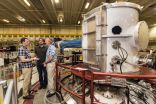(Press-News.org) MADISON, Wis. — The number of extremely hot days in Eastern and Midwestern U.S. cities is projected to triple by mid-century, according to a new study led by University of Wisconsin-Madison researchers and published today in the Journal of the American Medical Association.
Milwaukee and New York City could experience three times as many 90-degree days by 2046; Dallas could see twice as many days topping 100 degrees. The new analysis offers climate data through the lens of public health, in a study that represents a synthesis of the latest science at the intersection of climate change and human health.
In presenting their synthesis, the study authors seek to encourage efforts that benefit both the health of the planet and the health of people, the so-called co-benefits of reducing fossil fuel consumption and adapting to changes that are already underway.
"Climate change already is affecting global health," says Jonathan Patz, director of the UW-Madison Global Health Institute and lead author of the new study. "The good news is that clear health benefits are immediately available, from low-carbon strategies that today could result in cleaner air or to more active transport options that can improve physical fitness, ultimately saving lives and averting disease. "
Patz will present the article today at the Civil Society Event on Action in Climate Change and Health in New York. Acting U.S. Surgeon General Boris Lushniak; Maria Neira, World Health Organization (WHO) director for public health and the environment; Gina McCarthy, administrator of the U.S. Environmental Protection Agency; and many others will also participate in the event.
The study also includes UW-Madison associate professors Tracey Holloway and Daniel Vimont, both in the Nelson Institute for Environmental Studies and the Department of Atmospheric and Oceanic Sciences; Howard Frumkin from the University of Washington; and Andrew Haines of the London School of Hygiene and Tropical Medicine. It reviews the science behind some of the current and projected climate-related health risks.
Those include more extreme heat waves and storms, increased waterborne and infectious disease risks, more chronic health risks related to air pollution, and increased malnutrition and obesity-related risks from unhealthy, carbon-intensive diets.
"Climate change is an enormous public health challenge because it affects our health through multiple pathways," says Patz, also a professor in the Nelson Institute and the Department of Population Health Sciences at UW-Madison. "But if the risks are so interdependent, so, too, are the opportunities."
These opportunities include improvements to air quality, such as through reductions in unhealthy ozone, or smog. The study highlights a close association between the number of extremely hot days and the number of high-ozone days over the last several years in cities like Chicago, Milwaukee and Madison, Wisconsin.
This is "consistent with well-known linkages between climate and ozone in urban areas, and serves as a major pathway for the health impacts of climate change," Holloway says.
The analysis also lays out a number of science-based strategies to reduce global consumption of fossil fuels while improving health. These include designing sustainable cities, eating less meat, enacting better carbon policies (the costs of which could be more than offset by the potential health benefits they afford) and promoting active transport like walking or biking to work.
"Evidence shows there is a significant health benefit in active transport, particularly in the area of chronic disease," Patz says. "And with current disease trends in industrializing nations, burning less fossil fuel can yield potentially large dividends for public health."
The new study relied on an interdisciplinary team of experts in public health, air quality and climate science and offers opportunities across sectors.
"These findings dovetail with recent World Health Organization (WHO) studies that identified major health benefits from low carbon housing, transport and agriculture," says WHO health policy expert Carlos Dora. "Many of these benefits come from reductions in air pollution, but low carbon strategies also can increase physical activity, reduce traffic injuries and improve food security."
Patz is optimistic about recent policy developments and he says the article presents "a blueprint" for the public health benefits possible "if we really took on climate change."
INFORMATION:
The Civil Society Event on Action in Climate Change and Health, where the study will be released publicly, is co-sponsored by the University of Wisconsin Global Health Institute, the Nelson Institute for Environmental Studies, the Office of Sustainability and the Wisconsin Energy Institute. Additionally, the American College of Sports Medicine, Public Health Institute and the Global Climate and Health Alliance are co-leaders of the event.
CONTACT: Jonathan Patz, patz@wisc.edu, 608-698-7380 (until 9/24/14); after that date, email or Skype: jonathanpatz2. Or contact Ann Grauvogl, agrauvogl@wisc.edu, 608-265-9299
— Kelly April Tyrrell, 608-262-9772, ktyrrell2@wisc.edu
Actions on climate change bring better health, study says
2014-09-23
ELSE PRESS RELEASES FROM THIS DATE:
Sandia magnetized fusion technique produces significant results
2014-09-23
ALBUQUERQUE, N.M. — Researchers at Sandia National Laboratories' Z machine have produced a significant output of fusion neutrons, using a method fully functioning for only little more than a year.
The experimental work is described in a paper to be published in the Sept. 24 Physical Review Letters online. A theoretical PRL paper to be published on the same date helps explain why the experimental method worked. The combined work demonstrates the viability of the novel approach.
"We are committed to shaking this [fusion] tree until either we get some good apples or a ...
Critically ill ICU patients lose almost all of their gut microbes and the ones left aren't good
2014-09-23
Researchers at the University of Chicago have shown that after a long stay in the Intensive Care Unit (ICU) only a handful of pathogenic microbe species remain behind in patients' intestines. The team tested these remaining pathogens and discovered that some can become deadly when provoked by conditions that mimic the body's stress response to illness.
The findings, published in mBio®, the online open-access journal of the American Society for Microbiology, may lead to better monitoring and treatment of ICU patients who can develop a life-threatening systemic infection ...
Video blinds us to the evidence, NYU, Yale study finds
2014-09-23
Where people look when watching video evidence varies wildly and has profound consequences for bias in legal punishment decisions, a team of researchers at New York University and Yale Law School has found. This study raises questions about why people fail to be objective when confronted with video evidence.
In a series of three experiments, participants who viewed videotaped altercations formed biased punishment decisions about a defendant the more they looked at him. Participants punished a defendant more severely if they did not identify with his social group and punished ...
AWHONN recommends reducing overuse of labor induction
2014-09-23
Washington, DC, September 23, 2014 —The Association of Women's Health, Obstetric and Neonatal Nurses (AWHONN) is calling upon healthcare providers and pregnant women to avoid induction of labor at any time during pregnancy unless it is medically necessary.
Approximately one-in-four U.S. births are induced, a number that has more than doubled since 1990. While there are limited data to distinguish how many of these inductions are for medical and non-medical reasons, there is no data to suggest that the significant increase in the induction rate is attributable to a similar ...
New measure provides more data on oxygen levels during sedation
2014-09-23
September 23, 2014 – The "area under the curve of oxygen desaturation" (AUCDesat) may provide a more sophisticated approach to monitoring blood oxygen levels during procedures using sedation, according to a study published in Anesthesia & Analgesia.
The AUCDesat provides information not only whether blood oxygenation has dropped too low—but also on the depth, duration, and rate of episodes of oxygen desaturation. The new study by Paul Niklewski, PhD, of University of Cincinnati and colleagues reports on the development of the AUCDesat as a potentially useful new approach ...
Termites evolved complex bioreactors 30 million years ago
2014-09-23
Achieving complete breakdown of plant biomass for energy conversion in industrialized bioreactors remains a complex challenge, but new research shows that termite fungus farmers solved this problem more than 30 million years ago. The new insight reveals that the great success of termite farmers as plant decomposers is due to division of labor between a fungus breaking down complex plant components and gut bacteria contributing enzymes for final digestion.
Sophisticated Management in Termite Fungus Farms
Fungus-farming termites are dominant plant decomposers in (sub)tropical ...
Speaking of Chemistry: Why we need antibiotics (video)
2014-09-23
WASHINGTON, Sept. 23, 2014 — Antibiotics revolutionized health care in the early 20th century, helping kill bacteria that once killed thousands of people. But bacteria are also constantly outsmarting science, and new strains of antibiotic-resistant bacteria are popping up more frequently. This week's Speaking of Chemistry focuses on the current shortage of new antibiotics and discusses the prospects for new drugs. The episode also answers the question: Why should you finish your pills if you feel better? Check it out at: http://youtu.be/MAoDuSxXIUQ.
Antibiotics are just ...
Brain wave may be used to detect what people have seen, recognize
2014-09-23
Brain activity can be used to tell whether someone recognizes details they encountered in normal, daily life, which may have implications for criminal investigations and use in courtrooms, new research shows.
The findings, published in Psychological Science, a journal of the Association for Psychological Science, suggest that a particular brain wave, known as P300, could serve as a marker that identifies places, objects, or other details that a person has seen and recognizes from everyday life.
Research using EEG recordings of brain activity has shown that the P300 ...
Researchers develop new DNA sequencing method to diagnose tuberculosis
2014-09-23
Researchers working in the UK and The Gambia, have developed a new approach to the diagnosis of tuberculosis (TB) that relies on direct sequencing of DNA extracted from sputum (a technique called metagenomics) to detect and characterize the bacteria that cause TB without the need for time-consuming culture of bacteria in the laboratory.
The research, reported today in the peer-reviewed journal PeerJ, was directed by Professor Mark Pallen, Professor of Microbial Genomics at Warwick Medical School and Dr Martin Antonio, head of the TB diagnostics laboratory at UK Medical ...
Chimpanzees raised as pets or performers suffer long-term effects on their behavior
2014-09-23
Although the immediate welfare consequences of removing infant chimpanzees from their mothers are well documented, little is known about the long-term impacts of this type of early life experience. In a year-long study, scientists from Lincoln Park Zoon observed 60 chimpanzees and concluded that those who were removed from their mothers early in life and raised by humans as pets or performers are likely to show behavioral and social deficiencies as adults.
The multi-institutional research project, published today in the open-access journal PeerJ, was led by Steve Ross, ...


